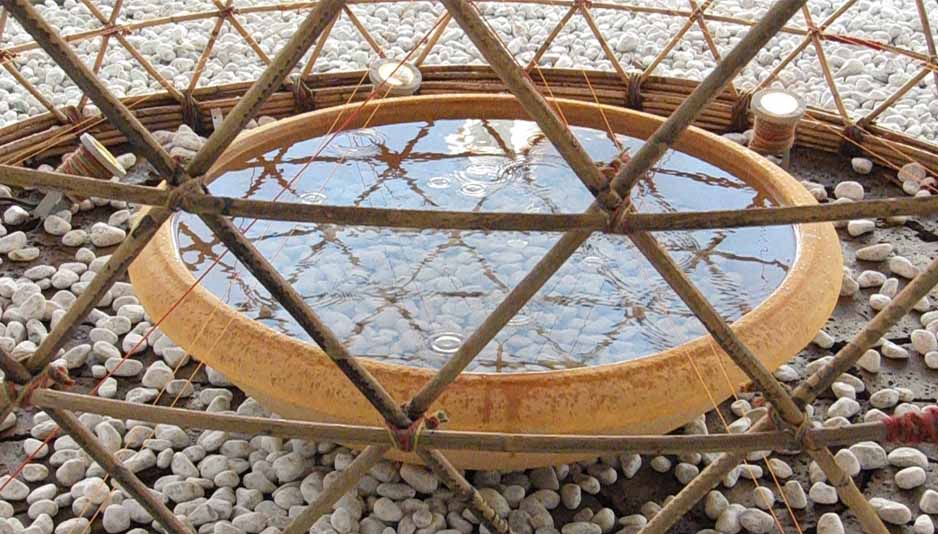Warka Water Tower: how to collect water from the atmosphere
Having the shape of a tree 30 meters high, ensure environmental sustainability, financial and social in the long term for the underdeveloped populations

dolcevitaonline.it
It is estimated that in the world there are at least 768 million people who die because they lack access to safe drinking water.
The architect Arturo Vittori, with its collaborator, Andreas Vogler of the study Architecture and Vision and with the support of the Italian Cultural Center in Addis Abeba and EiABC (Ethiopian Institute of Architecture, Building Construction and City Development) decided put an end to this problem.
Warka Water (derived from warka tree, large fig tree) is their project, presented for the first time at the Biennale of Architecture in Venice in 2012, and aimed at rural populations in developing countries, where the infrastructure and hygiene make it difficult access to drinking water.
BUT WHAT IS WARKA WATER?
It ‘a tower, having the shape of a tree, with the end to collect water from the atmosphere. It is designed to provide clean water and ensure environmental sustainability, financial and social, in the long term.
“Transforming the air in the water is a process that does not have anything special. They do ordinary dehumidifiers that we all at home. In the absence of electricity, in this case it uses the temperature difference between day and night, as did the Egyptians four thousand years ago “
Arturo Venturi
The obvious solution to solve the water shortage would dig wells, but drilling deeper than 500 meters in the rocky highlands of Ethiopia would be too expensive. Even when a well is dug, the maintenance of the pumps and the guarantee of a reliable electrical connection would make the project unlikely and unpromising.
STRUCTURE
architetturaecosostenibile.itInstead of looking to Western technology, Vittori has ispirarato Warka tree, a giant that defies gravity with her hair dome. This plant originated in Ethiopia produces fruits and is used as a gathering place in the community.
The structure weighs 88 kg and is wide in its widest point, 26 meters. However, it falls, at its smallest, has a width of a few meters.
yogui.coEach pillar is made up of two sections: a rigid exoskeleton built by tying the stems of rattan or bamboo with a plastic mesh inside, reminiscent of bags of oranges. The nylon and polypropylene fibers serve as a scaffold for the condensation, and, as the droplets of dew, they follow the shirt until you get to a basin at the base of the structure.
The use of natural fibers helps the tower to integrate with the landscape both visually and with the environmental context that with traditional techniques local.
It is composed of 5 modules that can be installed from the bottom upwards by 4 people without the need for scaffolding. Because of its light weight the system needs to be fixed to the ground.
WORKING
images.gizmag.comIt is based on a simple natural principle: that of the condensation of producing water through the temperature range during the day-night.
Outside, a carrying case allows air to pass, while inside a nylon mesh collects dew drops on the surface. The temperature difference between day and night creates the condensate that slides in a container and the water comes to a faucet through a hose.
The tower is able to collect more than 90 liters of drinking water per day, accumulating atmospheric water vapor.
From an ecological point of view, the system is inspired by the Namib beetle small, copying its strategies to adapt to climate. The small insect collects water from the desert by condensing the moisture on his abdomen, where it turns into tiny drops, which slipped on the back repellent, reach the mouth.
ECONOMIC ASPECTS OF THE PROJECT
Each tower costs about $ 550 and can be built in less than a week with a team of four people and locally available materials and therefore environmentally friendly.
grabcad.comHigh accessibility is an obstacle, since there seems no possibility of profit: this discourages potential investors. The solution has been to rely on the network, through crowdfunding.
It is then trying to implement a collective funding, using the Internet as a means of communication and collection. If it were in order, people’s lives would be made better. Also it would have the great advantage of offering a building manageable by local people, without any particular difficulties and skills.
It would take about $ 150,000 to turn the prototype into a concrete project.
After the first phase of testing at Bomarzo, Lazio, the first Warka Water has now been installed in a village in Ethiopia to provide water to its inhabitants.
